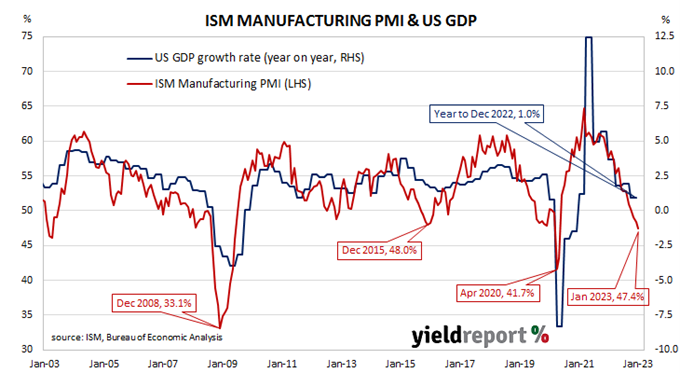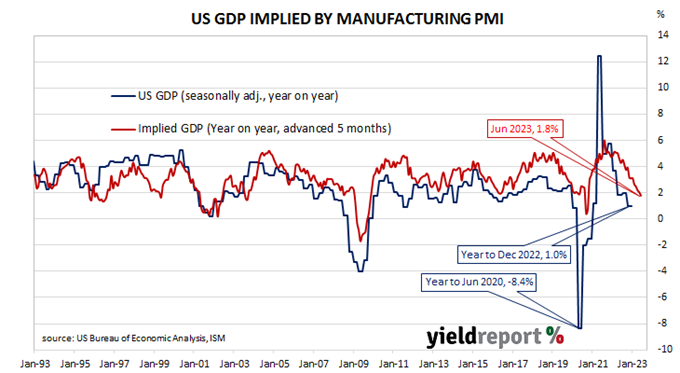Summary: ISM PMI down, at 47.4% in January, below expectations; Citi: should not extrapolate weakness to broader US economy; US yields down, expectations of higher rates soften; ISM: reading corresponds to 0.5% US GDP contraction annualised.
The Institute of Supply Management (ISM) manufacturing Purchasing Managers Index (PMI) reached a cyclical peak in September 2017. It then started a downtrend which ended in March 2020 with a contraction in US manufacturing which lasted until June 2020. Subsequent month’s readings implied growth had resumed, with the index becoming stronger through to March 2021. Since then, readings have declined steadily.
According to the ISM’s January survey, its PMI recorded a reading of 47.4%, below the generally expected figure of 48.0% as well as December’s revised figure of 48.4. The average reading since 1948 is 53.0% and any reading below 50% implies a contraction in the US manufacturing sector relative to the previous month.
“While ISM and S&P PMIs will be worth following closely in the coming months to get a sense of how manufacturing activity evolves, we would still caution against extrapolating this weakness to the broader economy,” said Citi analyst Gisela Hoxha.
The figures were published on the same day as several other reports as well as a 25bps increase to the federal funds target range. US Treasury yields moved considerably lower and, by the close of business, 2-year and 10-year Treasury bond yields had both shed 9bps to 4.12% and 3.42% respectively while the 30-year yield finished 7bps lower at 3.57%.
In terms of US Fed policy, expectations of higher federal funds rates over the next 12 months softened. At the close of business, contracts implied the effective federal funds rate would average 4.57% in February, 24bps higher than the current spot rate, and then climb to an average of 4.64% in March. May futures contracts implied a 4.88% average effective federal funds rate while December contracts implied 4.48%.
Purchasing managers’ indices (PMIs) are economic indicators derived from monthly surveys of executives in private-sector companies. They are diffusion indices, which means a reading of 50% represents no change from the previous period, while a reading under 50% implies respondents reported a deterioration on average. A reading “above 48.7%, over a period of time, generally indicates an expansion of the overall economy” according to the ISM.
The ISM’s manufacturing PMI figures appear to lead US GDP by several months despite a considerable error in any given month. The chart below shows US GDP on a “year on year” basis (and not the BEA annualised basis) against US GDP implied by monthly PMI figures.
According to the ISM and its analysis of past relationships between the PMI and US GDP, January’s PMI corresponds to an annualised contraction rate of 0.5%, or -0.1% over a quarter. Regression analysis on a year-on-year basis suggests a 12-month GDP growth rate of 1.8% five months after this latest report.
The ISM index is one of two monthly US PMIs, the other being an index published by S&P Global. S&P Global produces a “flash” estimate in the last week of each month which comes out about a week before the ISM index is published. The S&P Global flash January manufacturing PMI registered 46.8%, 0.6 percentage points higher than December’s final figure.



